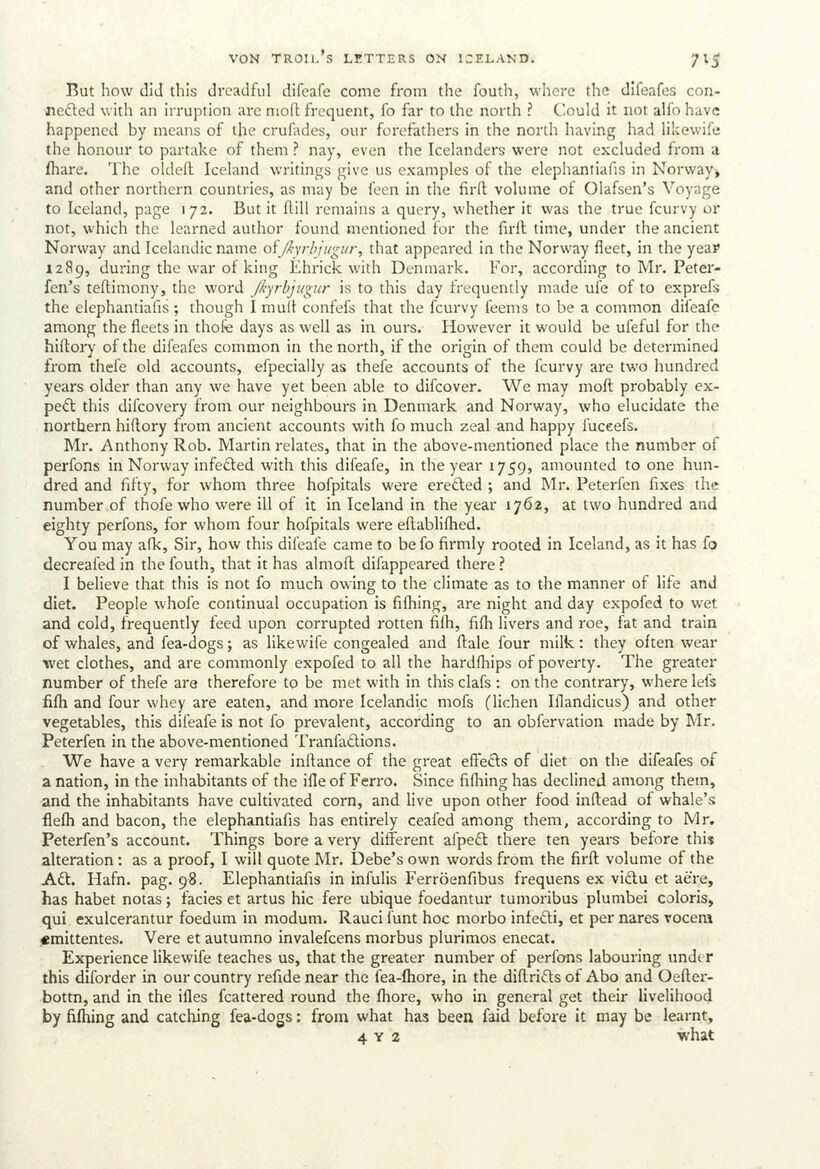
Full resolution (JPEG) - On this page / på denna sida - Pages ...

<< prev. page << föreg. sida << >> nästa sida >> next page >>
Below is the raw OCR text
from the above scanned image.
Do you see an error? Proofread the page now!
Här nedan syns maskintolkade texten från faksimilbilden ovan.
Ser du något fel? Korrekturläs sidan nu!
This page has never been proofread. / Denna sida har aldrig korrekturlästs.
VON TROIL’S LETTERS ON ICELAND. va)
But how did this dreadful difeafe come from the fouth, where the difeafes con-
nected with an irruption are moft frequent, fo far to the north? Could it not alfo have
happened by means of the crufades, our forefathers in the north having had likewife
the honour to partake of them? nay, even the Icelanders were not excluded from a
fhare. ‘The oldeft Iceland writings give us examples of the elephantiafis in Norway,
and other northern countries, as may be feen in the firlt volume of Olafsen’s Voyage
to Iceland, page 172. Butit ftill remains a query, whether it was the true {curvy or
not, which the learned author found mentioned for the firft time, under the ancient
Norway and Icelandic name of Ayrbjugur, that appeared in the Norway fleet, in the year
1289, during the war of king Ehrick with Denmark. For, according to Mr. Peter-
fen’s teftimony, the word /fyrbjugur is to this day frequently made ufe of to exprefs
the elephantiafis ; though I mult confefs that the fcurvy feems to be a common difeafe
among the fleets in thofe days as well as in ours: However it would be ufeful for the
hiftory of the difeafes common in the north, if the origin of them could be determined
from thefe old accounts, efpecially as thefe accounts of the {curvy are two hundred
years older than any we have yet been able to difcover. We may moft probably ex-
pect this difcovery from our neighbours in Denmark and Norway, who elucidate the
northern hiftory from ancient accounts with fo much zeal and happy fuceefs.
Mr. Anthony Rob. Martin relates, that in the above-mentioned place the number of
perfons in Norway infected with this difeafe, in the year 1759, amounted to one hun-
dred and fifty, for whom three hofpitals were erected; and Mr. Peterfen fixes the
number.of thofe who were ill of it in Iceland in the year 1762, at two hundred and
eighty perfons, for whom four hofpitals were eftablifhed.
You may afk, Sir, how this difeafe came to be fo firmly rooted in Iceland, as it has fo
decreafed in the fouth, that it has almoft difappeared there ?
I believe that this is not fo much owing to the climate as to the manner of life and
diet. People whofe continual occupation is fifhing, are night and day expofed to wet
and cold, frequently feed upon corrupted rotten fifh, fith livers and roe, fat and train
of whales, and fea-dogs; as likewife congealed and ftale four milk: they often wear
wet clothes, and are commonly expofed to all the hardfhips of poverty. The greater
number of thefe are therefore to be met with in this clafs: onthe contrary, where lefs
fifh and four whey are eaten, and more [celandic mofs (lichen Ilandicus) and other
vegetables, this difeafe is not fo prevalent, according to an obfervation made by Mr.
Peterfen in the above-mentioned ‘Tranfactions.
We have a very remarkable inftance of the great effects of diet on the difeafes of
a nation, in the inhabitants of the ifleof Ferro. Since fifhing has declined among them,
and the inhabitants have cultivated corn, and live upon other food inftead of whale’s
flefh and bacon, the elephantiafis has entirely ceafed among them, according to Mr.
Peterfen’s account. Things bore avery different afpect there ten years before this
alteration: as a proof, I will quote Mr. Debe’s own words from the firft volume of the
A&, Hafn. pag. 98. Elephantiafis in infulis Ferréenfibus frequens ex victu et aére,
has habet notas; facies et artus hic fere ubique foedantur tumoribus plumbei coloris,
qui. exulcerantur foedum in modum. Raucifunt hoc morbo infeéti, et per nares vocemi
emittentes. Vere et autumno invalefcens morbus plurimos enecat.
Experience likewife teaches us, that the greater number of perfons labouring under
this diforder in our country refide near the fea-fhore, in the diftricts of Abo and Oefter-
bottn, and in the ifles fcattered round the fhore, who in general get their livelihood
by fifhing and catching fea-dogs: from what has been faid before it may be resent
4Y¥2 what
<< prev. page << föreg. sida << >> nästa sida >> next page >>